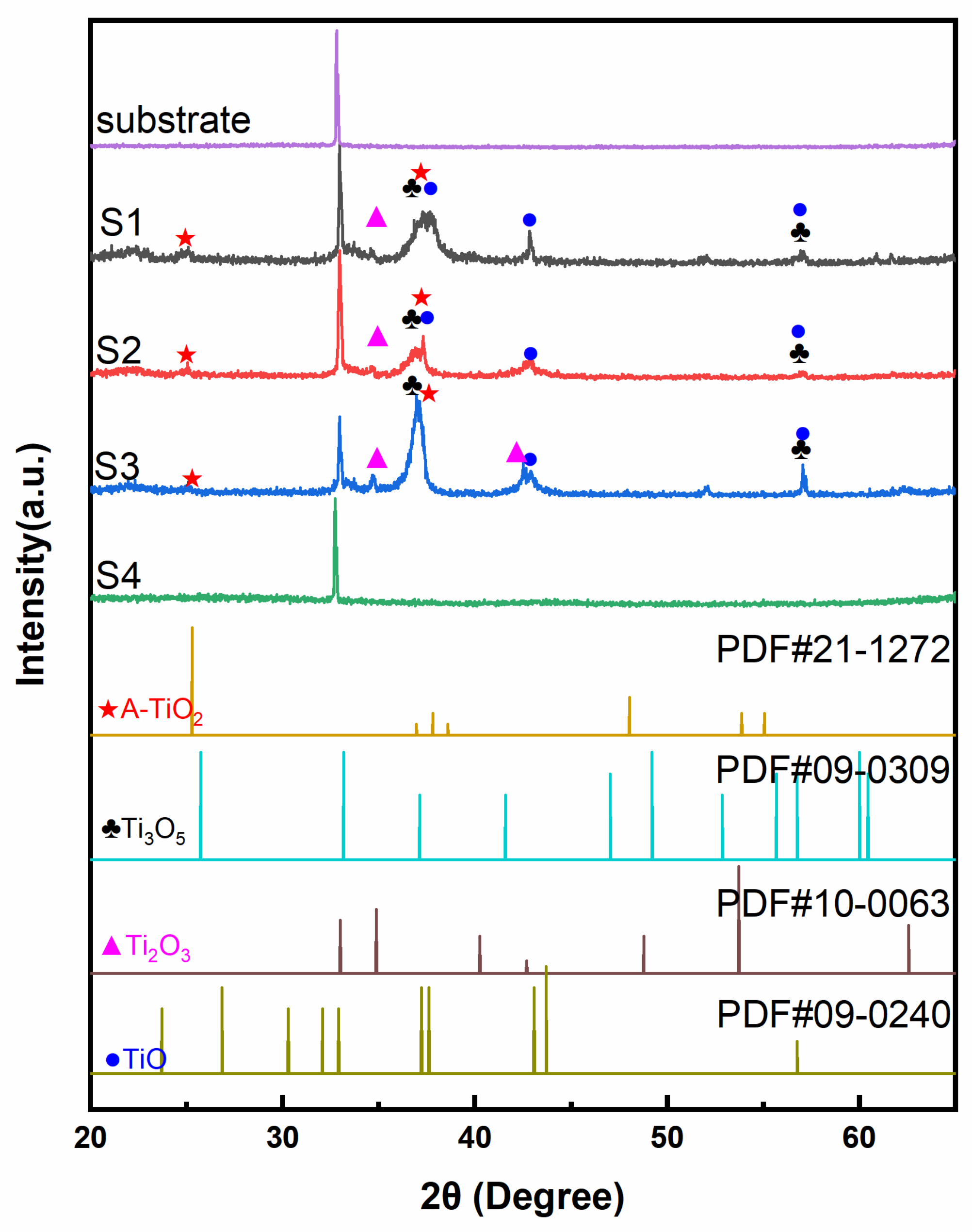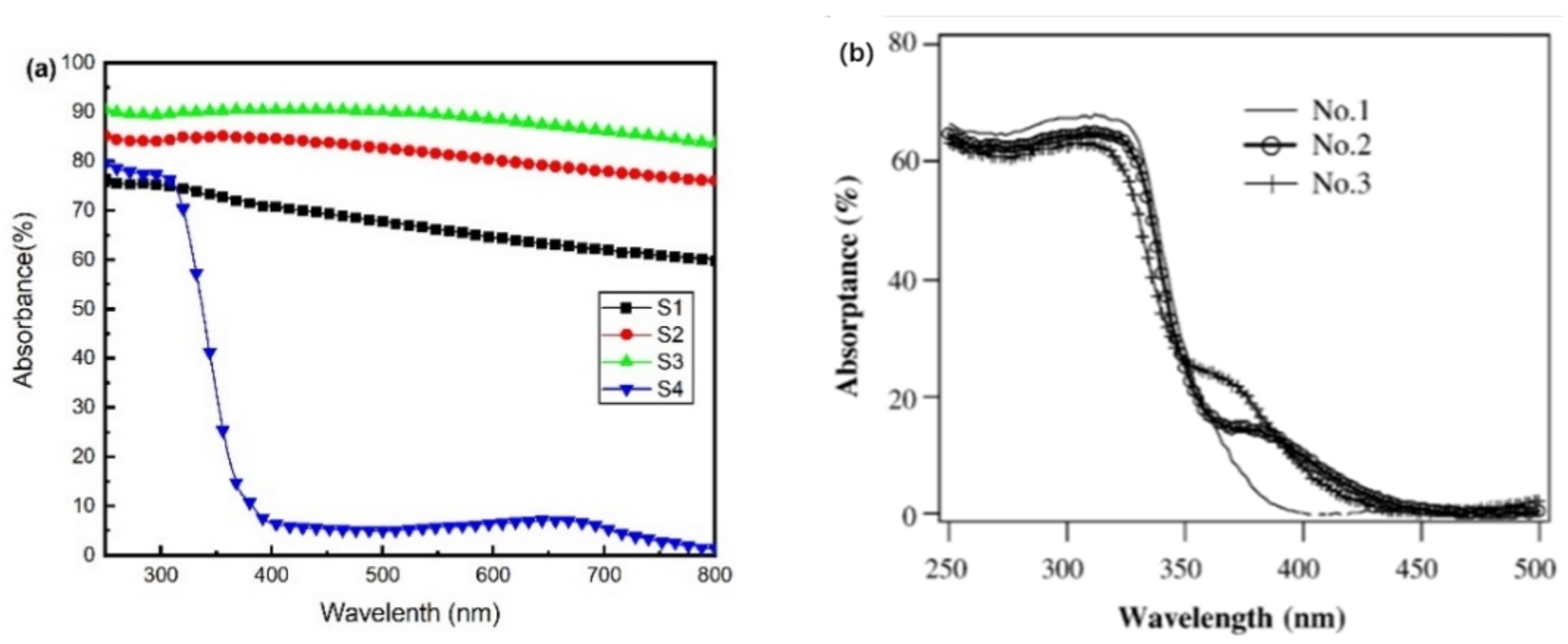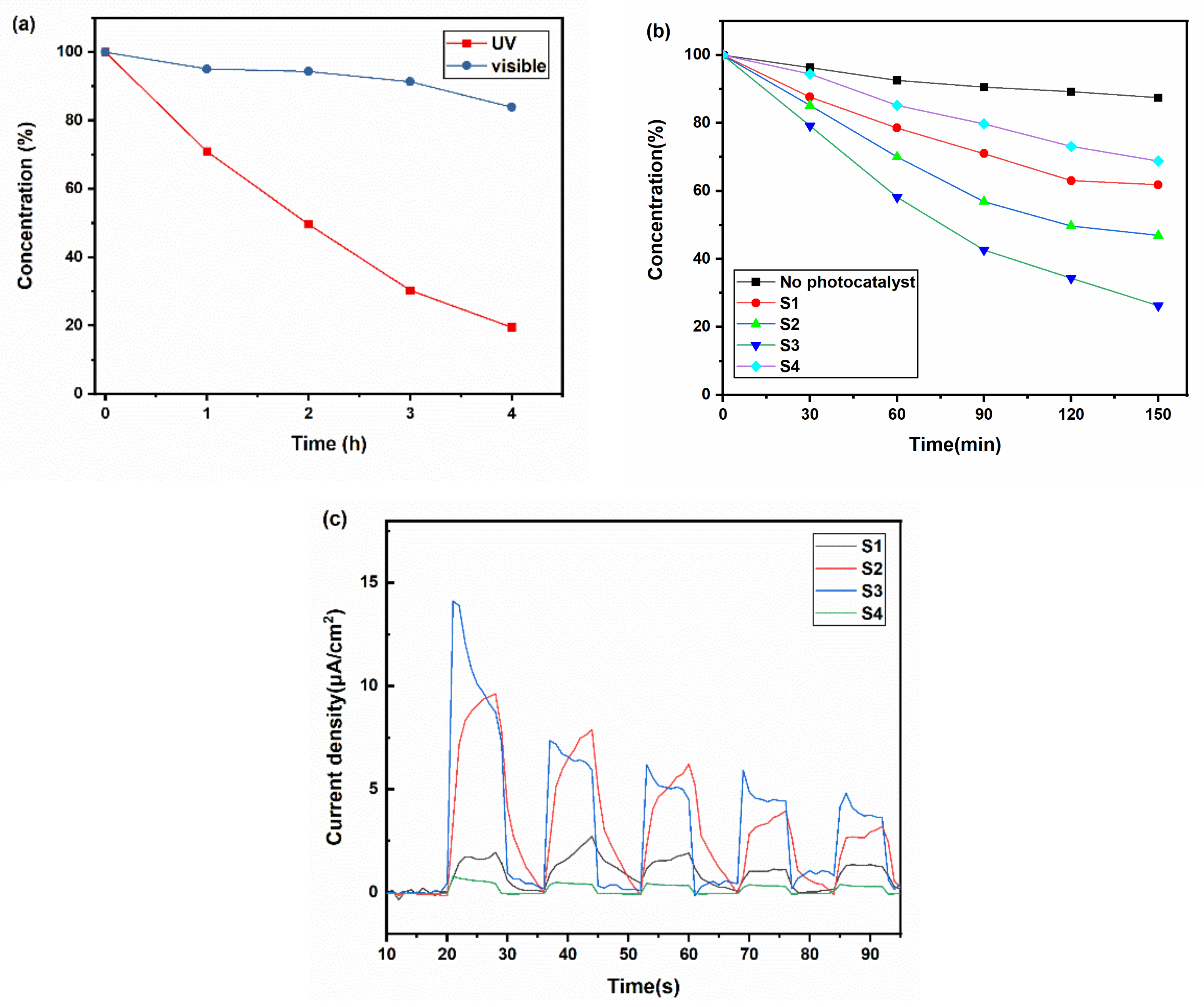Black TiOx Films with Photothermal-Assisted Photocatalytic Activity Prepared by Reactive Sputtering
Abstract
1. Introduction
2. Materials and Methods
2.1. Preparation of Black TiOx Films
2.2. Materials Characterization
2.3. Evaluation of Photothermal Effect and Photocatalytic Activity
3. Results and Discussion
3.1. Structure, Chemical Component, and Morphology
3.2. Optical Absorbance and Photothermal Conversion
3.3. Photocatalytic Activity
4. Conclusions
Supplementary Materials
Author Contributions
Funding
Institutional Review Board Statement
Informed Consent Statement
Data Availability Statement
Conflicts of Interest
References
- Chen, X.; Mao, S.S. Titanium dioxide nanomaterials: Synthesis, properties, modifications, and applications. Chem. Rev. 2007, 107, 2891–2959. [Google Scholar] [CrossRef] [PubMed]
- Asahi, R.; Morikawa, T.; Ohwaki, T.; Aoki, K.; Taga, Y. Visible-light photocatalysis in nitrogen-doped titanium oxides. Science 2001, 293, 269–271. [Google Scholar] [CrossRef] [PubMed]
- Chen, X.B.; Liu, L.; Yu, P.Y.; Mao, S.S. Increasing Solar Absorption for Photocatalysis with Black Hydrogenated Titanium Dioxide Nanocrystals. Science 2011, 331, 746–750. [Google Scholar] [CrossRef] [PubMed]
- Chen, X.B.; Liu, L.; Huang, F.Q. Black titanium dioxide (TiO2) nanomaterials. Chem. Soc. Rev. 2015, 44, 1861–1885. [Google Scholar] [CrossRef]
- Shan, Y.F.; Yang, Y.; Cao, Y.Q.; Yin, H.; Long, N.V.; Huang, Z.R. Hydrogenated black TiO2 nanowires decorated with Ag nanoparticles as sensitive and reusable surface-enhanced Raman scattering substrates. RSC Adv. 2015, 5, 34737–34743. [Google Scholar] [CrossRef]
- Pylnev, M.; Chang, W.H.; Wong, M.S. Shell of black titania prepared by sputtering TiO2 target in H2 + Ar plasma. Appl. Surf. Sci. 2018, 462, 285–290. [Google Scholar] [CrossRef]
- Lu, S.S.; Liu, F.L.; Qiu, P.X.; Qiao, M.; Li, Y.F.; Cheng, Z.W.; Xue, N.X.; Hou, X.K.; Xu, C.M.; Xiang, Y.B.; et al. Photothermal-assisted photocatalytic degradation with ultrahigh solar utilization: Towards practical application. Chem. Eng. J. 2020, 379, 8. [Google Scholar] [CrossRef]
- Wang, C.; Zhang, X. Anatase/Bronze TiO2 Heterojunction: Enhanced Photocatalysis and Prospect in Photothermal Catalysis. Chem. Res. Chin. Univ. 2020, 36, 992–999. [Google Scholar] [CrossRef]
- Wang, J.; Li, Y.Y.; Deng, L.; Wei, N.N.; Weng, Y.K.; Dong, S.; Qi, D.P.; Qiu, J.; Chen, X.D.; Wu, T. High-Performance Photothermal Conversion of Narrow-Bandgap Ti2O3 Nanoparticles. Adv. Mater. 2017, 29, 6. [Google Scholar] [CrossRef]
- Chong, M.N.; Jin, B.; Chow, C.W.K.; Saint, C. Recent developments in photocatalytic water treatment technology: A review. Water Res. 2010, 44, 2997–3027. [Google Scholar] [CrossRef]
- Zhou, Y.Y.; Xie, X.Y.; Song, L.X.; Guan, Y.L.; Yin, X.; Xiong, J. The preparation and properties of the flexible titanium oxide/carbon nanofibers film. Appl. Phys. A-Mater. 2017, 123. [Google Scholar] [CrossRef]
- Xu, W.X.; Zhu, S.; Fu, X.C. XPS study of TiOx thin films deposited on glass substrates by the sol-gel process. Appl. Surf. Sci. 1998, 136, 194–205. [Google Scholar] [CrossRef]
- Lu, X.J.; Chen, A.P.; Luo, Y.K.; Lu, P.; Dai, Y.M.; Enriquez, E.; Dowden, P.; Xu, H.W.; Kotula, P.G.; Azad, A.K.; et al. Conducting Interface in Oxide Homojunction: Understanding of Superior Properties in Black TiO2. Nano Lett. 2016, 16, 5751–5755. [Google Scholar] [CrossRef]
- Yang, L.L.; Peng, Y.S.; Yang, Y.; Liu, J.J.; Li, Z.Y.; Ma, Y.F.; Zhang, Z.; Wei, Y.Q.; Li, S.; Huang, Z.R.; et al. Green and Sensitive Flexible Semiconductor SERS Substrates: Hydrogenated Black TiO2 Nanowires. ACS Appl. Nano Mater. 2018, 1, 4516–4527. [Google Scholar] [CrossRef]
- Zapata-Torres, M.; Hernandez-Rodriguez, E.; Mis-Fernandez, R.; Melendez-Lira, M.; Calzadilla Amaya, O.; Bahena, D.; Rejon, V.; Pena, J.L. Visible and infrared photocatalytic activity of TiOx thin films prepared by reactive sputtering. Mater. Sci. Semicond. Process. 2015, 40, 720–726. [Google Scholar] [CrossRef]
- Feil, A.F.; Papaleo, R.M.; Hubler, R. Tuning the Crystalline Structure and Properties of TiOx Thin Films Deposited by DC Reactive Magnetron Sputtering by Adjusting the Ar/O2 Ratio. J. Nanosci. Nanotechnol. 2017, 17, 8967–8974. [Google Scholar] [CrossRef]
- Baroch, P.; Musil, J.; Vlcek, J.; Nam, K.H.; Han, J.G. Reactive magnetron sputtering of TiOx films. Surf. Coat. Technol. 2005, 193, 107–111. [Google Scholar] [CrossRef]
- Sproul, W.D.; Christie, D.J.; Carter, D.C. Control of reactive sputtering processes. Thin Solid Films 2005, 491, 1–17. [Google Scholar] [CrossRef]
- Depla, D.; Colpaert, A.; Eufinger, K.; Segers, A.; Haemers, J.; De Gryse, R. Target voltage behaviour during DC sputtering of silicon in an argon/nitrogen mixture. Vacuum 2002, 66, 9–17. [Google Scholar] [CrossRef]
- Zheng, S.K.; Xiang, G.; Wang, T.M.; Pan, F.; Wang, C.; Hao, W.C. Photocatalytic activity studies of TiO2 thin films prepared by r.f. magnetron reactive sputtering. Vacuum 2003, 72, 79–84. [Google Scholar] [CrossRef]
- Yu, X.; Shen, Z. Photocatalytic TiO2 films deposited on cenosphere particles by pulse magnetron sputtering method. Vacuum 2011, 85, 1026–1031. [Google Scholar] [CrossRef]
- Mohamed, E.M.; Nakamura, Y.; Fujii, Y.; Kamiya, M.; Rengakuji, S. High-quality growth of TiO2 thin film from its precursor solution by new sol-gel method. Electrochemistry 2004, 72, 455–457. [Google Scholar] [CrossRef]
- Yanagisawa, K.; Ovenstone, J. Crystallization of anatase from amorphous titania using the hydrothermal technique: Effects of starting material and temperature. J. Phys. Chem. B 1999, 103, 7781–7787. [Google Scholar] [CrossRef]
- Asbrink, S.; Magneli, A. Crystal structure studies on trititanium pentoxide, Ti3O5. Acta Crystallogr. 1959, 12, 575–581. [Google Scholar] [CrossRef]
- Hashimoto, S.; Tanaka, A.; Murata, A.; Sakurada, T. Formulation for XPS spectral change of oxides by ion bombardment as a function of sputtering time. Surf. Sci. 2004, 556, 22–32. [Google Scholar] [CrossRef]
- Di Paola, A.; Bellardita, M.; Palmisano, L.; Barbierikova, Z.; Brezova, V. Influence of crystallinity and OH surface density on the photocatalytic activity of TiO2 powders. J. Photochem. Photobiol. A Chem. 2014, 273, 59–67. [Google Scholar] [CrossRef]
- Boujday, S.; Wunsch, F.; Portes, P.; Bocquet, J.F.; Colbeau-Justin, C. Photocatalytic and electronic properties of TiO2 powders elaborated by sol-gel route and supercritical drying. Sol. Energy Mater. Sol. Cells 2004, 83, 421–433. [Google Scholar] [CrossRef]
- Lee, S.H.; Yamasue, E.; Okumura, H.; Ishihara, K.N. Effect of substrate roughness and working pressure on photocatalyst of N-doped TiOx films prepared by reactive sputtering with air. Appl. Surf. Sci. 2015, 324, 339–348. [Google Scholar] [CrossRef]
- Xagas, A.P.; Androulaki, E.; Hiskia, A.; Falaras, P. Preparation, fractal surface morphology and photocatalytic properties of TiO2 films. Thin Solid Films 1999, 357, 173–178. [Google Scholar] [CrossRef]
- Tanemura, S.; Miao, L.; Wunderlich, W.; Tanemura, M.; Mori, Y.; Toh, S.; Kaneko, K. Fabrication and characterization of anatase/rutile-TiO2 thin films by magnetron sputtering: A review. Sci. Technol. Adv. Mater. 2005, 6, 11–17. [Google Scholar] [CrossRef]
- Du, R.F.; Liu, W.; Bai, H.; Wang, H.T.; Xi, G.C. Metallic Ti3O5 hierarchical porous microspheres with an enhanced photothermal property. RSC Adv. 2020, 10, 2075–2084. [Google Scholar] [CrossRef]
- Janus, M.; Kusiak-Nejman, E.; Morawski, A.W. Influence of water temperature on the photocatalytic activity of titanium dioxide. React. Kinet. Mech. Catal. 2012, 106, 289–295. [Google Scholar] [CrossRef]
- Perez-Gonzalez, M.; Tomas, S.A.; Santoyo-Salazar, J.; Morales-Luna, M. Enhanced photocatalytic activity of TiO2-ZnO thin films deposited by dc reactive magnetron sputtering. Ceram. Int. 2017, 43, 8831–8838. [Google Scholar] [CrossRef]
- Wang, B.; Qi, H.J.; Liu, Z.Q.; Jin, Y.X.; Wang, H.; Yuan, J.L.; Zhao, J.L.; Shao, J.D. Structure, chemical state and photocatalytic activity of TiO2-x nanostructured thin films by glancing angle deposition technique. J. Alloys Compd. 2017, 716, 299–305. [Google Scholar] [CrossRef]
- Fakhouri, H.; Arefi-Khonsari, F.; Jaiswal, A.K.; Pulpytel, J. Enhanced visible light photoactivity and charge separation in TiO2/TiN bilayer thin films. Appl. Catal. Gen. 2015, 492, 83–92. [Google Scholar] [CrossRef]
- Ma, R.; Sun, J.; Li, D.H.; Wei, J.J. Review of synergistic photo-thermo-catalysis: Mechanisms, materials and applications. Int. J. Hydrogen Energy 2020, 45, 30288–30324. [Google Scholar] [CrossRef]





| Sample | Voltage/V | O2 Flow/sccm | Ar Flow/sccm | Average Absorbance/% |
|---|---|---|---|---|
| S1 | 360 ± 5 | 3.4 ± 0.2 | 36.6 ± 0.2 | 67.37 |
| S2 | 380 ± 5 | 5.2 ± 0.2 | 34.8 ± 0.2 | 81.50 |
| S3 | 400 ± 5 | 5.6 ± 0.2 | 34.4 ± 0.2 | 89.29 |
| S4 | 420 ± 5 | 6.0 ± 0.2 | 34.0 ± 0.2 | 17.87 |
| Sample | S1 | S2 | S3 |
|---|---|---|---|
| O: Ti (XPS) | 1.30 | 1.20 | 1.29 |
| O: Ti (EDS) | 0.67 | 1.07 | 1.23 |
| Ti4+/% | 30.73 | 43.89 | 44.27 |
| Ti3+/% | 19.65 | 24.41 | 26.44 |
| Ti2+/% | 39.01 | 31.70 | 29.29 |
| Ti/% | 10.61 | 0 | 0 |
| Sample | S1 | S2 | S3 |
|---|---|---|---|
| PV/nm | 29.90 | 49.98 | 58.76 |
| RMS/nm | 3.53 | 6.40 | 7.84 |
| Ra/nm | 2.79 | 5.08 | 6.26 |
| Thickness/nm | 580 | 700 | 800 |
| Average particle size/nm | 30.0 | 38.7 | 40.2 |
| Materials and Methods | Simulated Pollutant | Light Source | Degradation Rate/%·h−1 |
|---|---|---|---|
| RF magnetron sputtering, TiO2 [20] | Rhodamine-B (0.5 mg/L) | 8 W-254 nm | 25 |
| Pulse magnetron sputtering, TiO2 [21] | Methyl orange (10 mg/L) | 36 W-365 nm | 23 |
| DC reactive sputtering ZnO2/TiO2 [33] | Methylene blue (10 mg/L) | 15 W-254 nm | 15–21 |
| Glancing angle deposition [34], H-TiOx | Methylene blue (10 mg/L) | AM 1.5 G | 22–31 |
| RF magnetron sputtering, TiN/TiO2 [35] | Rhodamine-B (5 mg/L) | 500 W full wavelength | 20–40 |
| Our work | Rhodamine-B (10 mg/L) | 25 W-254 nm | 13–30 |
Publisher’s Note: MDPI stays neutral with regard to jurisdictional claims in published maps and institutional affiliations. |
© 2021 by the authors. Licensee MDPI, Basel, Switzerland. This article is an open access article distributed under the terms and conditions of the Creative Commons Attribution (CC BY) license (https://creativecommons.org/licenses/by/4.0/).
Share and Cite
Mao, Q.; Liu, M.; Li, Y.; Wei, Y.; Yang, Y.; Huang, Z. Black TiOx Films with Photothermal-Assisted Photocatalytic Activity Prepared by Reactive Sputtering. Materials 2021, 14, 2508. https://doi.org/10.3390/ma14102508
Mao Q, Liu M, Li Y, Wei Y, Yang Y, Huang Z. Black TiOx Films with Photothermal-Assisted Photocatalytic Activity Prepared by Reactive Sputtering. Materials. 2021; 14(10):2508. https://doi.org/10.3390/ma14102508
Chicago/Turabian StyleMao, Quan, Meng Liu, Yajie Li, Yuquan Wei, Yong Yang, and Zhengren Huang. 2021. "Black TiOx Films with Photothermal-Assisted Photocatalytic Activity Prepared by Reactive Sputtering" Materials 14, no. 10: 2508. https://doi.org/10.3390/ma14102508
APA StyleMao, Q., Liu, M., Li, Y., Wei, Y., Yang, Y., & Huang, Z. (2021). Black TiOx Films with Photothermal-Assisted Photocatalytic Activity Prepared by Reactive Sputtering. Materials, 14(10), 2508. https://doi.org/10.3390/ma14102508








